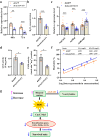AANAT1 regulates insect midgut detoxification through the ROS/CncC pathway
- PMID: 38961219
- PMCID: PMC11222512
- DOI: 10.1038/s42003-024-06505-x
AANAT1 regulates insect midgut detoxification through the ROS/CncC pathway
Abstract
Insecticide resistance has been a problem in both the agricultural pests and vectors. Revealing the detoxification mechanisms may help to better manage insect pests. Here, we showed that arylalkylamine N-acetyltransferase 1 (AANAT1) regulates intestinal detoxification process through modulation of reactive oxygen species (ROS)-activated transcription factors cap"n"collar isoform-C (CncC): muscle aponeurosis fibromatosis (Maf) pathway in both the oriental fruit fly, Bactrocera dorsalis, and the arbovirus vector, Aedes aegypti. Knockout/knockdown of AANAT1 led to accumulation of biogenic amines, which induced a decreased in the gut ROS level. The reduced midgut ROS levels resulted in decreased expression of CncC and Maf, leading to lower expression level of detoxification genes. AANAT1 knockout/knockdown insects were more susceptible to insecticide treatments. Our study reveals that normal functionality of AANAT1 is important for the regulation of gut detoxification pathways, providing insights into the mechanism underlying the gut defense against xenobiotics in metazoans.
© 2024. The Author(s).
Conflict of interest statement
The authors declare no competing interests.
Figures






References
Publication types
MeSH terms
Substances
LinkOut - more resources
Full Text Sources
Other Literature Sources

